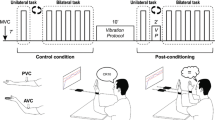Abstract.
An emerging view in motor control research is that voluntary movements typically require little effort. Nonetheless, there is no agreed-upon method for measuring movement-related effort. To pursue such a method, we conducted two experiments. In the first, participants oscillated the forearm about the elbow in the horizontal plane at different frequencies. After performing each task, they gave an effort rating. The forearm movements caused a cursor to move back and forth between two targets on a computer screen, and we changed the gain of the system, requiring different angular displacements to produce the same cursor displacement, thus keeping the visual demands the same while varying the motor demands. Surprisingly, the ratings increased as the amplitudes of forearm rotation decreased, and the performance scores that participants received were also worse the smaller the amplitudes of forearm rotation. The latter result suggests that participants simply rated as effortful those movements for which knowledge of results indicated poor performance. To seek a more direct link between motor activity and rated effort, in the second experiment we asked participants to oscillate the forearm about the elbow in the horizontal plane at different metronome-specified frequencies, but we allowed participants to generate whatever angular displacements they wished to incur different levels of prescribed effort. With this procedure, we found that angular velocity was proportional to prescribed effort. The simplicity of this outcome suggests that the method used in the second experiment can be used in the future as a means of evaluating biomechanically related effort. The surprising finding of the first experiment suggests that Fitts' Law depends both on perception and on motor control.
Similar content being viewed by others
Author information
Authors and Affiliations
Additional information
Electronic Publication
Rights and permissions
About this article
Cite this article
Rosenbaum, D.A., Gregory, R.W. Development of a method for measuring movement-related effort. Exp Brain Res 142, 365–373 (2002). https://doi.org/10.1007/s00221-001-0925-4
Received:
Accepted:
Issue Date:
DOI: https://doi.org/10.1007/s00221-001-0925-4




